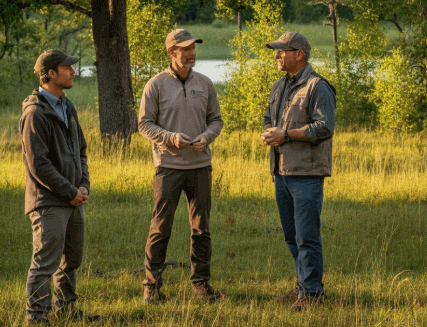Buying land for wildlife habitat or conservation projects has never been more critical, as wildlife populations have declined by an average of 68% over the last 50 years. Private land plays a key role in creating wildlife corridors, with research showing that 60% of such corridors in certain areas are privately owned. Steve Daria and Joleigh, renowned real estate investors and experts in land purchases, stress the importance of investing in land to support these vital ecosystems while achieving personal and financial goals. Whether you’re passionate about safeguarding endangered species or supporting the global mission to protect 30% of the planet’s land by 2030, buying land for wildlife habitat or conservation projects can make a meaningful difference. By utilizing strategies such as conservation easements and community-based initiatives, you can help create safe habitats for wildlife while adding long-term value to your property. Steve Daria and Joleigh recommend a seamless cash-buying process for those ready to take action. Want to learn more? Book a free consultation today to see how you can support conservation efforts while growing your investment portfolio—no obligation required!
Key Points
- Understand the Land’s Ecological Value: Research the land’s role in supporting wildlife and maintaining natural habitats. This can include factors like its location within migration corridors or its suitability for endangered species.
- Consider Conservation Benefits: Purchasing land for conservation helps protect ecosystems and promotes biodiversity. This can align with global goals, such as safeguarding 30% of land by 2030 while leaving a positive environmental legacy.
- Explore Tax Incentives: Conservation agreements, like easements, can offer significant tax benefits. These agreements often allow you to preserve the land’s natural state while reducing property taxes.
- Factor in Long-Term Plans: Think about how you’ll manage and protect the property over time. This may include planting native species, removing invasive plants, or collaborating with organizations dedicated to conservation efforts.
- Seek Expert Guidance: Professionals like Steve Daria and Joleigh, known for their expertise in cash land purchases, can simplify the process. Consulting experts ensure that your investment meets both environmental and personal goals.
Why is it important to buy land for wildlife habitat or conservation projects?
Buying land for wildlife habitat or conservation projects is crucial for preserving biodiversity and supporting ecosystems.
Many animal species rely on natural habitats to survive, but these areas are disappearing quickly due to urbanization and deforestation.
By securing land, you can protect essential spaces where wildlife can thrive, ensuring their survival for future generations.

Research indicates that private land plays a crucial role in establishing wildlife corridors, which enable animals to migrate safely and maintain healthy populations.
Conservation also benefits humans by maintaining clean air, water, and soil, which are vital for our health and well-being.
Protecting land often aligns with global efforts, like the initiative to safeguard 30% of Earth’s land by 2030.
Additionally, this type of investment can provide financial benefits, such as tax incentives and long-term appreciation in land value.
Whether you care about the environment or seek a rewarding investment, buying land for wildlife habitat or conservation projects is a meaningful way to make a positive impact.
Get Started: Get Your Cash Offer Below…
We are direct land buyers. There are no commissions or fees and no obligation whatsoever. Start below by sharing where your property is and where we can send your offer…
What types of land are ideal for conservation projects?
The most suitable types of land for conservation projects are those that support diverse ecosystems and possess natural features beneficial to wildlife.
Regions rich in native vegetation, wetlands, and water sources like rivers or ponds are ideal habitats, offering animals essential resources such as food, shelter, and safe breeding grounds.
Lands located within migration corridors or near protected areas can also play a critical role in connecting habitats and supporting species movement.
Forested regions or meadows filled with native plants are excellent choices as they help preserve biodiversity.
When buying land for wildlife habitat or conservation projects, it’s important to consider the location’s importance to threatened or endangered species.
Lands prone to urban development may also be valuable for conservation as they can shield ecosystems from further disruption.
Additionally, properties with minimal invasive plant species and healthy soil significantly enhance conservation outcomes.
Choosing land with these features ensures long-term benefits for wildlife and contributes to global efforts to protect natural habitats.
Are there financial incentives for land conservation?
- Tax Deductions Through Conservation Easements: Many landowners can receive tax benefits by entering into conservation easements. These agreements preserve the land while reducing property or income taxes in exchange for maintaining its undeveloped status.
- Property Tax Reductions: Some states offer lower property taxes for land designated for conservation or wildlife habitat. This can help landowners save money while contributing to environmental protection.
- Government Grants and Programs: Federal and state governments often provide financial grants or cost-sharing programs for land conservation efforts. These can cover expenses like habitat restoration or implementing sustainable practices.
- Carbon Credit Opportunities: By preserving forests or planting trees on your land, you may qualify for carbon credit programs. These credits can be sold to companies aiming to offset their carbon emissions, creating an additional income stream.
- Wildlife Habitat Incentives: Programs like the Wildlife Habitat Incentives Program (WHIP) reward landowners who enhance or maintain habitats for certain species. These incentives make it easier to manage land responsibly while supporting conservation goals.
How can I assess if land is suitable for wildlife habitat?
To assess if the land is suitable for wildlife habitat, start by evaluating its natural features, such as the presence of native plants, water sources, and diverse vegetation types that provide food and shelter for animals.
Check if the property lies within known migration corridors or near protected areas, as these locations are important for species movement.
Research local ecosystems to determine if threatened or endangered species inhabit the area, as conserving their habitats can have a significant environmental impact.
If you’re considering purchasing land for wildlife habitat or conservation projects, conduct a site visit to identify signs of existing wildlife, like animal tracks, nests, or burrows.
Look for lands with limited invasive plant species and healthy soil conditions, as these enhance habitat quality.
Consulting with conservation experts or using tools like environmental assessments can help you make an informed decision.
Consider the property’s potential for long-term conservation, such as adding native plants or creating natural buffer zones.
By carefully analyzing these factors, you can ensure the land you choose will effectively support wildlife and conservation goals.
What are the legal requirements when buying land for conservation?
- Understand Zoning and Land Use Restrictions: Verify whether the land is zoned for conservation or if any local regulations restrict its use. This step is crucial when purchasing land for wildlife habitat or conservation projects to ensure compliance with environmental laws.
- Research Conservation Easements: Some lands may already be under conservation easements, which limit development and preserve natural habitats. If you’re buying land for wildlife habitat or conservation projects, it’s important to understand how these easements affect property ownership and usage.
- Review Environmental Assessments: Many properties require environmental assessments to confirm their suitability for conservation. These assessments identify potential hazards or protections that can influence your plans for wildlife habitat management.
- Verify Water and Resource Rights: Ensure you have the legal rights to access water or natural resources on the land. This is especially important for conservation projects that rely on maintaining healthy ecosystems.
- Check for Protected Species Laws: Some lands may house endangered species, which are protected by specific laws. Knowing these laws helps you align your efforts when purchasing land for wildlife habitat or conservation projects, thereby avoiding legal complications and supporting your conservation goals.
- Understand Local Permit Requirements: Certain conservation projects may necessitate specific permits, particularly if they involve altering the land. These permits can include water management, land clearing, or the construction of small structures, such as observation decks or fences.
- Seek Legal Guidance: Consulting an attorney familiar with conservation laws can simplify the buying process. They can help you address any legal complexities and ensure your conservation project is compliant with all regulations.

What can I do after buying land for wildlife habitat?
After buying land for wildlife habitat or conservation projects, there are many steps you can take to enhance its value and protect its ecosystems.
Begin by assessing the land to identify native plants and wildlife and create a plan to preserve them.
Planting native vegetation and eliminating invasive species are effective ways to foster a healthier habitat for local wildlife.
Consider incorporating features such as water sources or natural shelters to support local wildlife.
Partnering with conservation groups or local experts can provide valuable guidance and resources to support your efforts.
It’s also important to monitor the land regularly to ensure it remains free from threats like pollution or illegal activities.
By maintaining the land’s natural state, you contribute to broader conservation goals and leave a lasting legacy.
Take the next step by reaching out to experts or conservation organizations to maximize the impact of your newly acquired land.
**NOTICE: Please note that the content presented in this post is intended solely for informational and educational purposes. It should not be construed as legal or financial advice or relied upon as a replacement for consultation with a qualified attorney or CPA. For specific guidance on legal or financial matters, readers are encouraged to seek professional assistance from an attorney, CPA, or other appropriate professional regarding the subject matter.
